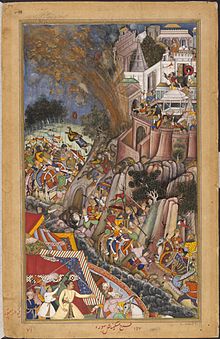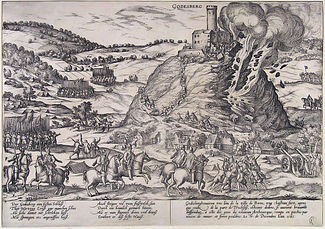- Sapping
-
Sapping is a term used in siege operations. Any trench excavated under defensive musket or artillery fire that was intended to advance a besieging army's position in relation to the works of an attacked fortification was referred to as a sap. Saps of approach were excavated by brigades of trained soldiers, often called sappers, because they dug the saps, or specifically instructed troops of the line.
By using the sap, or trench, a siege force could move closer to the walls of a fortress, without exposing troops to direct fire from the defending force, called enfilade. Once the saps were close enough, miners were often brought in to dig tunnels under the walls in which they would place bombs or powder kegs. Using long fuses, they would ignite the explosives and the ensuing force would create a gap in the fortification's defenses.
Contents
The age of gunpowder
During Cologne War, in the Siege of Godesberg, even the large caliber cannons brought to bear on the fortress by the superior force of the Ferdinand of Bavaria had little impact on the fortress itself. The cannons were firing heavy shells, but the height of the fortress significantly reduced the power with which they could hit the walls. Although the fortress dated from the 14th century, its construction caused the cannonballs to "bounce" from the walls, having little impact. To breach the walls, Ferdinand ordered his soldiers to dig into the feldspar supporting the side of the mountain. Even when the powder was ignited and a substantial portion of the wall, the gate, and the inner walls were blown into the air, the defenders still held out for three days.[1]
Trace Italienne
Main article: Trace ItalienneSapping became a necessary process after the development of the Italian style bastion, or trace Italienne, in defensive architecture that made siege warfare the modus operandi of military operations in the late medieval and first decades of the early modern period of warfare.[2] Fortresses boasting abutments with gentler angles were difficult to breach; cannonballs and mortar shells often had little impact on the walls, or impact that could be readily repaired after night fell. Towers no longer protruded at right angles from the wall; rather, they blended with the wall. These created a two-fold advantage. First, defenders in the towers had a field of fire of 280 degrees or more. This range of fire and the towers' positioning allowed them to fire upon the attackers' flank as they advanced, a deadly fire called enfilade. Consequently, a seco which range their cannons were less effective.[clarification needed][3]
16th century
 It illustrates an incident when a mine exploded during the Mughal attack on the Rajput fortress of Chitor (Chittaurgarh) in north-west India in 1567, killing many of the besieging Mughal forces. In right side Mughal sappers are shown preparing covered paths to enable the army to approach the fortress, while their opponents fiercely defend themselves.
It illustrates an incident when a mine exploded during the Mughal attack on the Rajput fortress of Chitor (Chittaurgarh) in north-west India in 1567, killing many of the besieging Mughal forces. In right side Mughal sappers are shown preparing covered paths to enable the army to approach the fortress, while their opponents fiercely defend themselves.
During the Dutch Revolt, the Spanish controlled Groningen and the road leading to the German states, called the Bourtange passage. William I of Orange decided to build a fortification there to secure the road, which the Spanish were using to bring men and equipment into the provinces. The fort was completed in 1593. The star fort, or trace italienne, had a support network of canals and lakes, used as moats for additional protection. These were also constructed in the design of stars, giving the defenders added security. At the time of its completion, the fort housed five garrisons. Soon after its construction, Spanish forces from Groningen unsuccessfully besieged it.[4]
American Civil War
In the American Civil War, troops advanced their sap under cover of a sap roller[5] or mantlet[6] by forming a parapet on the engaged side of the trench one gabion at a time and filling it with earth taken from the trench.
See also
References
- Notes
- ^ (German) Ernst Weyden. Godesberg, das Siebengebirge, und ihre Umgebung. Bonn: T. Habicht Verlag, 1864, p. 43.
- ^ Charles Townshend (editor). The Oxford history of modern war. Oxford: Oxford University Press. 2000, p. 28.
- ^ Townshend, pp. 28-29.
- ^ An Universal history pg. 455 [1]
- ^ http://civilwarfortifications.com/dictionary/xgs-003.html
- ^ http://civilwarfortifications.com/dictionary/xgm-003.html
- Bibliography
- Campell, E.S.N (1844). A Dictionary Of The Military Science:Containing an Explanation Of The Principal Terms Used In Mathematics, Artillery, and Fortification, And Comprising The Substance Of The Latest Regulations On Courts Martial, Pay, Pension, Allowances, Etc. A Comparative Table Of Ancient And Modern Geography; Achievements Of The British Army; With An Address to Gentlemen Entering The Army. (New edition ed.). London: James Maynard. http://civilwarfortifications.com/library/campbell/index-frame.html. Retrieved 2007-11-19.
- Townshend (editor)., Charles (2000). The Oxford history of modern war. Oxford: Oxford University Press.
- (German) Weyden, Ernst (1864). Godesberg, das Siebengebirge, und ihre Umgebung. Bonn: T. Habicht Verlag.
External links
Categories:
Wikimedia Foundation. 2010.



